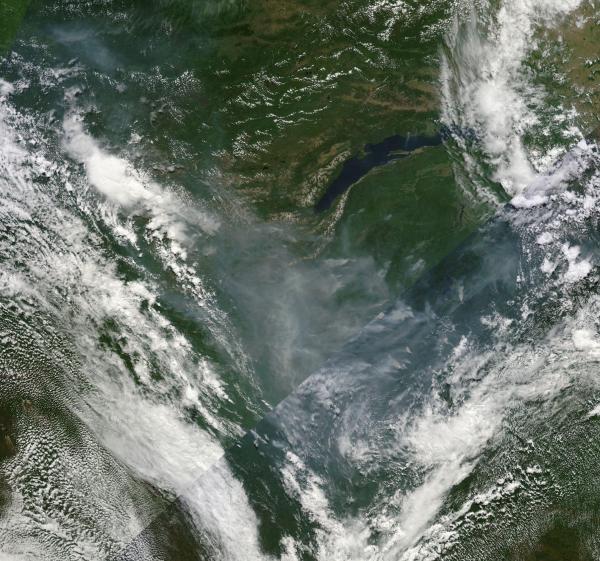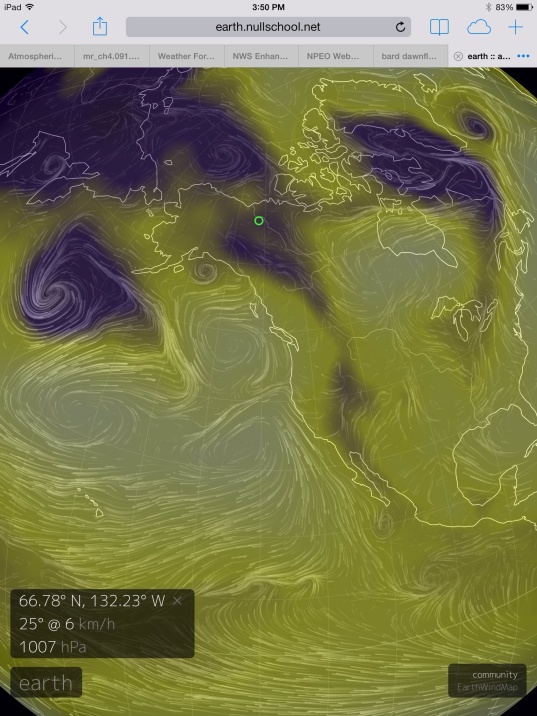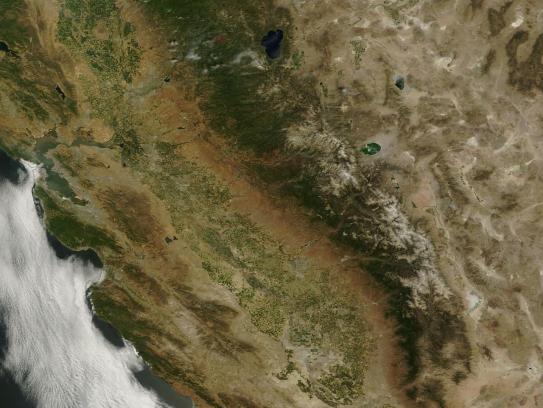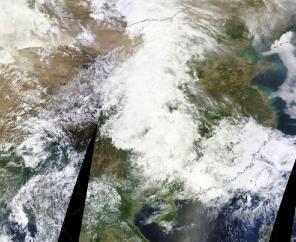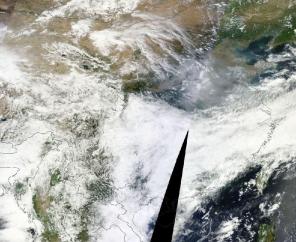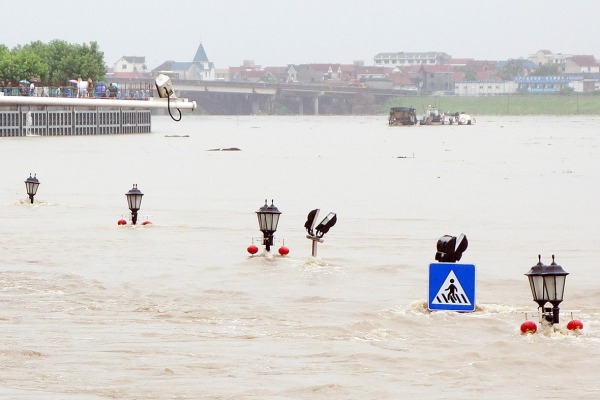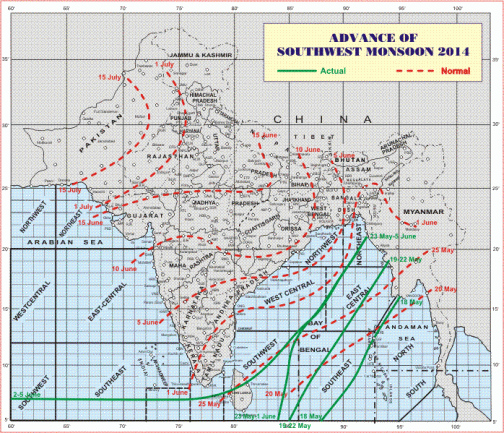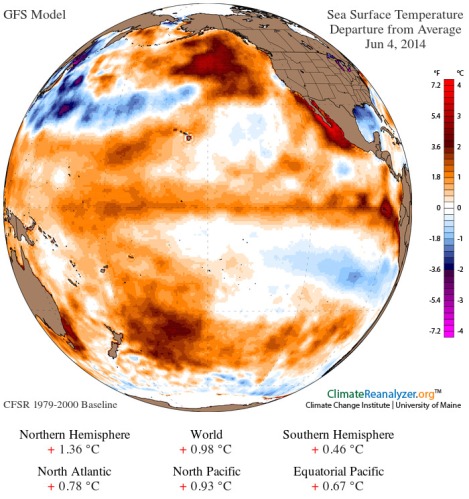The white, reflective barrier protecting our northern polar region from the heat-amplifying effects of human-caused warming took a severe blow today. The National Snow and Ice Data Center’s sea ice area measure essentially fell off a cliff as values plummeted by more than 286,000 square kilometers. That’s an area of ice the size of Nevada lost in a single 24 hour period. A state-sized region flipping from white, reflective, cooling ice, to dark, heat-absorptive water.
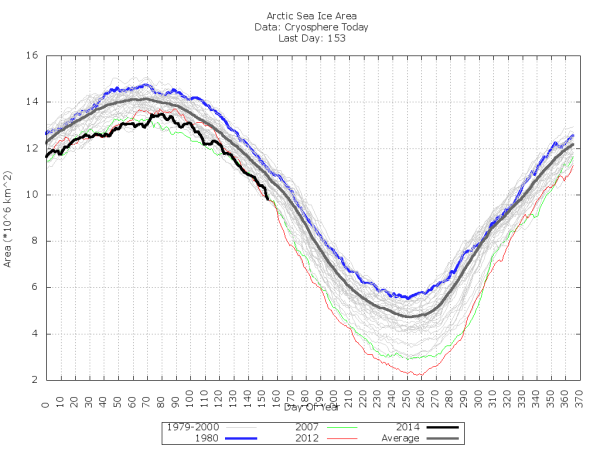
(Most recent day’s sea ice area measure shows vertical drop for June 2nd and a near vertical drop for June 3rd. Updated graph shows June 3, 2014 area measures tied with 2011 and 2012 for record low daily levels. Data source: Cryosphere Today/NSIDC. Image source: Pogoda i Klimat.)
Overall, the sprawl of sea ice fell to 9,984,000 square kilometers or a negative 907,000 square kilometer anomaly vs the already low 1979 to 2008 mean. The fall was rapid enough to bring sea ice area to within striking distance of new record lows for the date. Should the nose-dive continue for just one more day, the measure’s lower range will be shattered.
Arctic Still Warm as Extra Heat Goes to Work on Ice
Since May, weather conditions in the Arctic above the 66.5 degrees north Latitude line have remained somewhat warmer than usual. GFS averages have ranged from +1.5 to -0.3 C when compared to the, already warm, 1979 to 2000 average. And, in general, values have typically hovered in the +0.5 C range for the entire Arctic.
This temperature anomaly range is, however, a major fall from the extreme polar amplification we saw this winter on the order of +4 to +6 C above ‘normal’ temperatures during the months of January and February of 2014. It is the same relative winter-to-summer draw-down in anomalies we would expect come summer as the heat overburden goes to work doing the physical heavy lifting of ice melt rather than simply warming the air. In essence, as atmospheric and ocean temperatures approach the 28 F melt-freeze line of sea ice, energy, instead, is dumped more and more into ice melt. So though Summer is still quite a bit warmer than Winter in the Arctic, the pace of atmospheric warming in the winter is much greater so long as temperatures remain below ice-melt thresholds.
Heat Delivery Mechanisms: How Polar Amplification Melts Sea Ice
Extra dangerous and amplifying Arctic heat comes from many sources. Not only is the atmosphere over the Arctic more heavily burdened with heat-capturing gasses than the rest of the planet (currently at about 405.5 ppm CO2 and 1910 ppb methane as measured at NOAA’s Barrow Alaska station), high amplitude jet stream waves continue to deliver heat in the form of southerly warm wind invasions even as the ocean upon which the thinning ice rests draws ever more energy from an immense volume of warming water. Expanding holes in the ice, a darker, greener, Arctic environment, a rain of soot from massive wildfires burning at the Arctic’s gates — all contribute to overall warming in the Arctic system.
How this heat is delivered to the sea ice can take many forms. The first, and most obvious, is through direct solar heating of the ice itself. Such insolation heating requires both clear skies and warm air temperatures for greatest impact. In these ideal conditions, melt ponds can proliferate, greatly reducing sea ice albedo and further weakening ice for large melts later in the season. And recent studies suggest that widespread melt pond formation played a key role in both of the record melt seasons of 2007 and 2012.

(Thin ice over Hudson Bay, Canada on June 2 takes on the characteristic blue tint indicative of melt pond formation. During late spring of 2014, melt pond formation was relegated to the ice edge, primarily due to widespread cloud formation over the Arctic Ocean. Image source: LANCE MODIS.)
But for 2014, melt pond formation has been relegated to the ice edge boundary along the fast ice near Russia, in regions of the Canadian Arctic Archipelago, and in Hudson Bay. Large areas of cloud cover have persisted throughout the Arctic preventing a much more widespread occurrence of melt ponds. This high degree of cloudiness is likely due to the changing Arctic itself where increasing encounters between hot and cold are veritable cloud and mist generating machines. Such changes bear out in paleoclimate observations where proxy values show a more ice free Arctic is a much cloudier Arctic.
So if clouds interrupt solar insolation in a melting Arctic, then what other mechanisms go to work to deliver heat to the ice?
Weather Systems, Warming Lands and Waters
‘Fate,’ as the saying goes, ‘is not without its sense of irony.’ For water in all forms, including the low-lying clouds which are fogs and mists, is likely to play an ever-increasing role in Arctic melt. These emerging heat delivery mechanisms can simply be summed up as follows: warm wet winds, warm water upwelling, and warm rivers.
Warm Wet Winds blow from south to north and increasingly invade the Arctic as tundra melts and sea ice retreats. As summer temperatures at the Arctic boundary increase due to human forcings and related amplifying feedbacks, these warm, southerly gusts bear with them an ever-increasing moisture content. And since water has 4 times the heat capacity of air, winds laden with higher volumes of moisture carry much more heat to melt ice than the drier, colder winds of yore. When such winds contact the ice, a form of condensation mist is wrung out of the air due to temperature differential. The mist directly contacts the ice and delivers its x4 heat capacity to the ice surface. It’s a phenomena that many coastal residents in the northeastern US are well familiar with — something they call snow-eating fog.
During late spring of 2014, warm, wet winds were particularly prevalent in the region of the Bering and Chukchi Seas. These winds weren’t much warmer than sea ice freezing temperatures — ranging from 28 to 40 degrees F. But they picked up moisture in a large south to north synoptic pattern, dredging up heat and water from the temperate Pacific to dump it on the Arctic sea ice. The result was great gusts of mists and fogs eating away at the ice edge week-after-week.
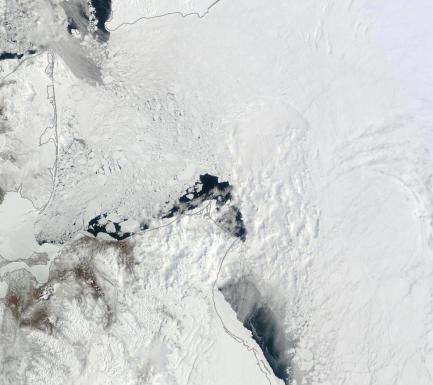

In the above satellite image sequence (LANCE MODIS), we can see the drastic effects of prevalent warm winds. The top image is from April 25 of 2014, the bottom from June 2nd. In the top frame we can see the beginnings of mist and cloud formation at the ice edge along the path of persistent south to north wind flow. By June 2nd, this warm wind pattern has melted most of the Bering and Chukchi sea ice even as it intensified to a misty, cloudy maelstrom chewing away at the ice edge.
A more intense kind of a warm wind forcing can come in the form of a warm storm. These storms typically emerge from the south carrying with them a high degree of heat and moisture. A combination of rain, strong winds and increased wave action over sea ice can have a severe effect during a warm storm as was seen during the Great Arctic Cyclone of 2012. Such storms are likely to become more prevalent as the Arctic continues to heat up. And these systems can also generate a kind of warm water upwelling that eats away at the ice from below.
Warm Water Upwelling is an especially powerful force to melt ice that sits on a warming ocean, particularly when the ice is as thin, broken and mobile as we see in the Arctic today.
Impacts from warming and upwelling deep ocean waters have been both extraordinary and increasingly visible to major glacial systems in Greenland and West Antarctica where numerous ice sheets have begun an irreversible plunge toward the oceans.
In the Arctic, heat typically pools in deeper layers and at the near-shore below-surface boundary along the continental shelf. The ice rests in a zone of colder water at the surface. Atmospheric patterns such as persistent and strong high and low pressure systems can occasionally tap this deeper water heat through a mechanism known as Ekman pumping.
The way this works is that a large-scale swirl of air creates a kind of suction effect on the sea surface. In cyclonic storms, Ekman pumping causes upwelling to occur at the center of the storm and down-welling to occur at the edges. In high pressure systems, upwelling occurs along the edges while down-welling occurs at the center.

(Illustration of Ekman transport is cyclonic [storm] and anticyclonic [high pressure] systems. Image source: MIT.)
The effect this has on sea ice is that storms will tend to spread the ice out and thin it at their centers while high pressure systems will tend to pull the ice edge in and concentrate the ice. In addition, the upwelling at the edges of the anticyclone can add melt stress, especially in more shallow coastal basins, even as melt stress is added along storm paths in which warmer waters may have ventured closer to the ice bottom.
During the last week, a persistent high pressure system formed over the Beaufort Sea. It sat opposite a set of cyclones that formed near the Kara. The anticyclonic pattern of the high drew in ice from land-fast moorings in the East Siberian Sea even as warm upwelling and loss of albedo generated warmer surface temperatures in an expanding polynya zone — pumping out a burst of ice-eating mists. The anticyclone expanded into the Laptev where a similar edge draw and surface warming effect was visible even as the wind patterns between anticyclone and cyclone converged to amplify the northward retreat of ice.


In the top LANCE MODIS image frame we see East Siberian and Laptev seas already suffering ice loss and break-up due to a series of warm wind outbursts from the Asian continent on May 15 of this spring. In the bottom frame, we see today’s sea ice coverage dramatically reduced after a week of extreme ice damage due to anticyclonic recession and related edge upwelling.
As a result, both Laptev Sea ice and East Siberian Sea ice are well into record lowest ranges.
Warm Rivers also typically provide a strong pulse of heat to the Arctic through spring and into summer. As the Arctic lands thaw and the large continents warm, water flows from thawed rivers increase. In recent years, Jet Stream wave amplification has combined with warming temperatures in the region of 55 to 75 North Latitude to increase storminess and rainfall intensity. As a result, higher volumes of warmed waters flood north into what was once the ice sanctuary of the Arctic Basin. The pulse of water is generally enough to disintegrate land-fast ice and speed the ice melt further offshore.
Though large warm water pulses are not yet visible, regions to watch for 2014 will be the Mackenzie Delta and the mouths of the Kolyma, Lena, Yenisey, and Ob rivers. Major rainfall events in Siberia have been ongoing over the past week and will likely generate increased volumes of warm water flow for the Lena and Yenisey rivers particularly.
It is also worth noting that much warmer than average conditions have spread over the Mackenzie and Ob river basins.
Forecast Shows High Rate of Melt Likely
Today’s weather shows a continued building of the high pressure ridge over the Beaufort with GFS model forecasts predicting the ridge will remain in place over at least the next seven days. Persistence of this ridge pattern will continue to draw the ice in from the East Siberian and Laptev Seas even as warm winds over the Chukchi are reinforced. Sea ice totals may further be drawn down from rapid melt proceeding in both Hudson and Baffin Bay. Melt in these areas has lagged behind the larger Arctic somewhat, so current near record low totals are yet higher than they would otherwise be.

(107 hour GFS Model temperature forecast. Image source: University of Maine.)
Meanwhile, model runs show the Arctic steadily devolving into a kind of melt soup where atmospheric temperatures push into an above-freezing range for sea ice over the majority of the Arctic even as shore regions of Yakutia and the Mackenzie Delta are forecast to see temperatures in the mid 60s and 70s. These readings are in the daily range of +0.3 to +1.9 C above the 1979 to 2000 average for the entire area above the Arctic Circle and are predicted to hit local spikes from +4 to +18 C.
It should go without saying that a 70 degree reading in early June on the shores of the East Siberian Sea in the high Arctic is a clear sign of human-caused climate change gone nuts. And we are likely to see these and higher readings as spring proceeds into summer.
So though general cloudiness over the Arctic may continue to suppress melt pond formation, there likely remains enough heat baked-in to keep testing new record lows for sea ice. Even under cloud cover, dangers to the sea ice abound in the form of warm winds, warm storms, warm water upwelling, and a growing heat pulse from warming Arctic rivers. Amplifying heat and a growing number of ways in which that heat can be transferred to ice creates an ever-expanding risk for ice free conditions. Under such a regime, unexpected and extreme events are increasingly likely.
* * * *
UPDATE: According to reports from NSIDC and Cryosphere Today, negative Arctic sea ice area anomaly for the date grew to 988,000 square kilometers below the average for June 3rd. This represents an additional loss of 179,000 square kilometers, which is larger than the combined land masses of the UK and Croatia (or roughly the size of the state of Missouri). This most recent plunge pushes 2014 sea ice into record low range as it essentially ties values for both 2011 and 2012 on this date. Any single day loss greater than 120,000 square kilometers for tomorrow will extend 2014 losses into all-time record low range.
In total, the plunge over June 2-3 represents 465,000 square kilometers or an area larger than the combined regions of California and Maryland. It is worth noting that weekly losses in the range of 500,000 square kilometers are considered extreme. We have instead witnessed a near 500,000 square kilometer loss in just two days.

(Thin ice visible over broad stretches of the Arctic. Image source: Uni-Bremen.)
As an additional note, it’s worth sharing the observation that while high pressure systems and warm winds have placed extreme melt pressure and caused the ice edge to rapidly recede in the Chukchi, East Siberian and Laptev seas, ongoing cyclonic action in a rough triangle from the North Pole to Greenland to the Kara Sea has resulted in a great breaking, thinning and dispersal of ice in this region. The cyclones in the area, though weak, have generated enough force to greatly disperse the ice and, perhaps, to access warmer waters just below the ice in sections where ice has repeatedly expanded and retracted over recent months. Large patches of sea ice concentration of less than 75% in this zone make it very vulnerable to any additional heat and melt forcing.
So it appears the Arctic is split between weather forces — with cyclones dominating the sea ice between the North Pole, the Kara, and the coasts of Greenland and with high pressure systems dominating the Beaufort and the Laptev. Forecast higher temperatures injected into what is already a strong melt regime continue to generate high risk for rapid melt.
Links:
Cryosphere Today/NSIDC
Pogoda i Klimat
Arctic Ice Graphs
Arctic Sea Ice
LANCE MODIS
MIT
GFS Model
University of Maine
NSIDC MASIE plots

